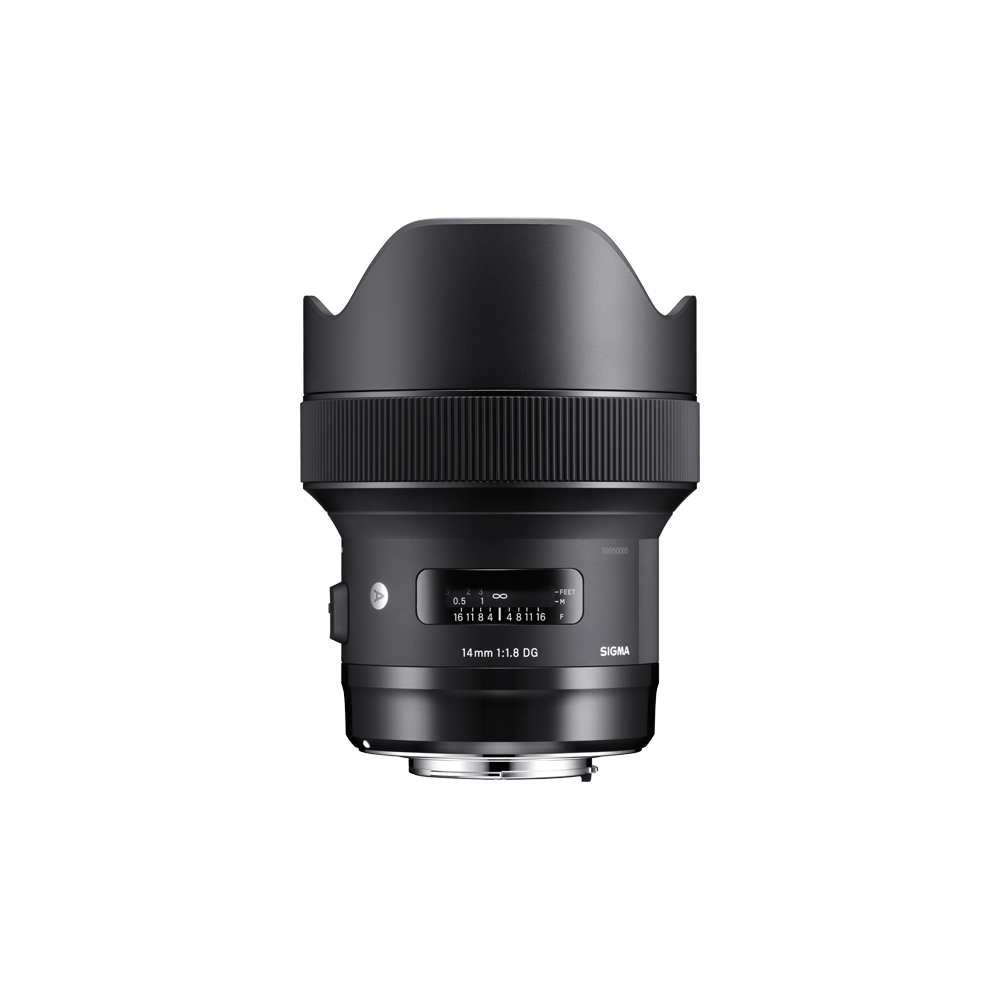
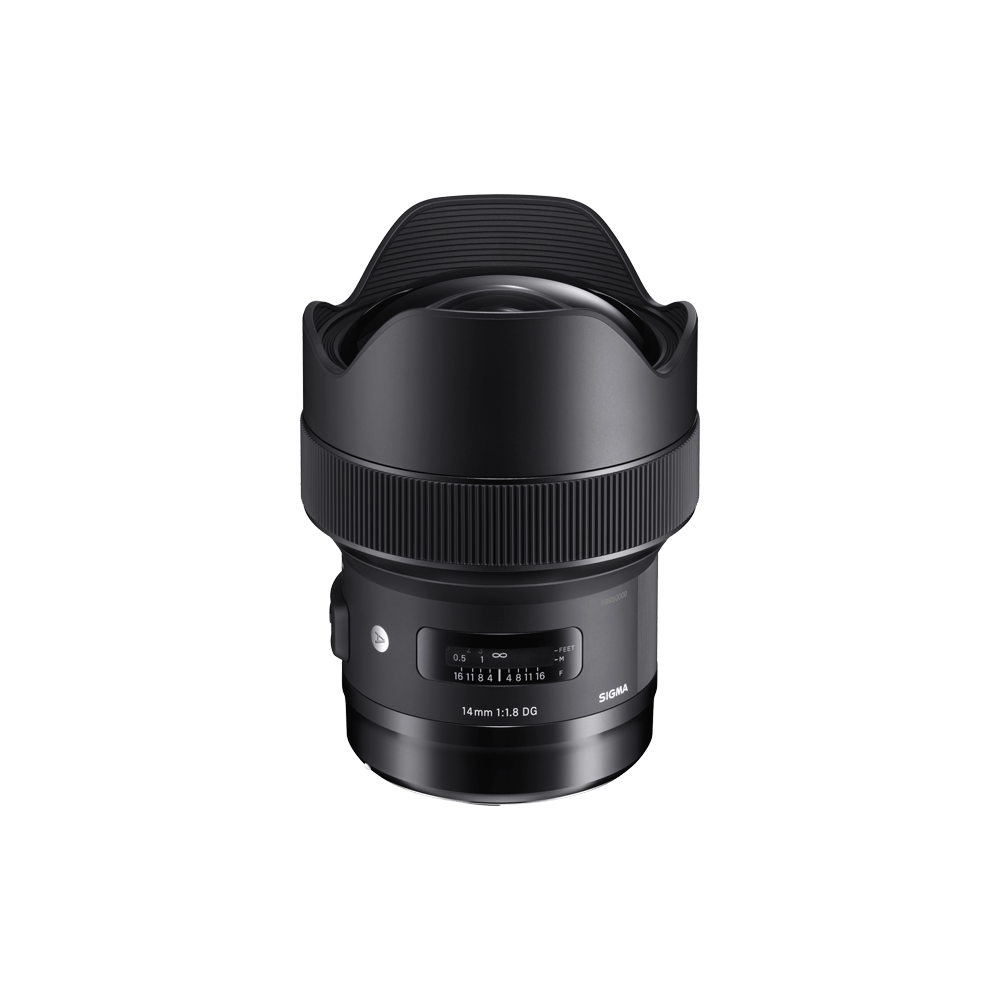


Art
14mm F1.8 DG HSM
Available mounts
- L-Mount
- Sony E-mount
- Sigma SA-mount
- Canon EF mount
- Nikon F mount
-
Camera Type
DSLR
-
Corresponding Mount
L-Mount, Sony E-mount, SIGMA SA-mount, Canon EF mount, Nikon F mount
-
Sensor Format
Full-frame [DG]
-
Lens Construction
16 elements in 11 groups
-
Angle of View
114.2°
-
Number of Diaphragm Blades
9 (Rounded diaphragm)
-
Minimum Aperture
F16
-
Minimum Focusing Distance
27cm / 10.6in.
-
Maximum Magnification Ratio
1:9.8
-
Dimensions (Diameter × Length)
SIGMA SA-mount:φ95.4mm × 126mm / φ3.8in. × 5.0in.
Sony E-mount:φ95.4mm × 152mm / φ3.8in. × 6.0in.
L-Mount:φ95.4mm × 150mm / φ3.7in. × 5.9in.
*The length of a lens is measured from the filter surface to its mount.
-
Weight
SIGMA SA-mount:1,120g / 39.5oz.
Sony E-mount:1,170g / 41.3oz.
L-Mount:1,185g / 41.8oz.
-
Edition Number
A017
The three-digit code on the surface of the lens is to indicate the year the lens was first released.
(Since it is different from the year of manufacture, the release year and edition number may not match depending on the mount.) -
Supplied Accessories
・Case
・COVER LENS CAP LC954-01
・REAR CAP LCR II -
Mount / Product Barcode
SIGMA SA-mount:00-85126-45056-4 (discontinued)
Sony E-mount:00-85126-45065-6 (discontinued)
L-Mount:00-85126-45069-4
Nikon F mount:00-85126-45055-7 (discontinued)
Canon EF mount:00-85126-45054-0 (discontinued)
-
Camera Compatibility
LINK
-
* The Nikon mount version of this lens includes an electromagnetic diaphragm mechanism. Functionality may be limited on some camera bodies. For Nikon F mount cameras, please see (*)Nikon camera compatibility
* This product is developed, manufactured and sold based on the specifications of E-mount which was disclosed by Sony Corporation under the license agreement with Sony Corporation.
* L-Mount is a registered trademark of Leica Camera AG.(*)Nikon F mount camera compatibility
Lenses for Nikon F mount with an electromagnetic diaphragm mechanism can be used with the following cameras.
Z7Ⅱ※,Z7※,Z6Ⅱ※,Z6※,Z5※,Z50※,D6, D5, D4S, Df, D850, D810, D810A, D780, D750, D610, D500, D7500, D7200, D7100, D5600, D5500, D5300, D5200, D5100, D5000, D3500, D3400, D3300, D3200, D3100
※Can be used with the Nikon "Mount Adapter FTZ" attachedBefore using with one of the cameras listed below, please update the lens to the latest firmware version.
D4, D3X, D3S, D3, D800, D800E, D700, D600, D300S, D300, D7000
* The lens cannot be used with the cameras not listed above (including film single‐lens reflex cameras).
-
14mm ultra-wide-angle and F1.8 brightness: a new dimension of visual experience
A mode of expression that was unavailable—until now
By leveraging its extreme angle of view and the dramatic perspective this creates, an ultra-wide-angle lens can get up close and personal with a subject while at the same time taking in a vast background—an example of photography going beyond normal human vision.
Sigma 14mm F1.8 DG HSM | Art combines the extremely deep depth of field that comes from an ultra-wide angle of view with the extremely shallow depth of field that comes from F1.8 brightness. The result is a sharply captured subject set against a vast background dramatically blurred with a beautiful bokeh effect. It’s a highly impressive mode of photographic expression that until now simply hasn’t existed.
-
Minimized chromatic aberrations
Three FLD (“F” Low Dispersion) glass elements and four SLD (Super Low Dispersion) glass elements help minimize transverse chromatic aberration, which tends to be noticeable in shots taken with ultra-wide-angle lenses. Offering excellent peripheral brightness, this lens delivers outstanding image quality from the center to the edges.
-
Minimized distortion
Serving as the front lens element, the large φ80mm precision-molded glass aspherical lens effectively minimizes distortion. Offering excellent peripheral brightness, this lens delivers outstanding image quality from the center to the edges.
-
Featuring a large-diameter aspherical lens element
The Sigma 12-24mmF4 DG HSM | Art was the first Sigma lens to feature a large φ80mm aspherical lens element. Building on the expertise derived from this success, the new lens features a large ⌀80mm precision-molded glass aspherical lens as its front element. This technology has made possible the 14mm F1.8 specification—the first of its kind.
-
Distinctive bokeh effect
Even at the 14mm ultra-wide-angle of view, F1.8 brightness makes possible a very shallow depth of field with the subject standing out dramatically against a bokeh background. It’s the unique mode of expression that only a large-diameter lens can deliver.
-
Exclusive low-dispersion glass
The degree to which light is refracted by glass depends on the light’s wavelength. This fact causes different colors of light to focus at slightly different points. The result is chromatic aberration, the color fringing that is particularly noticeable in telephoto lenses. Most chromatic aberration can be removed by combining a high-refractivity convex lens element with a low-refractivity concave element. Yet residual chromatic aberration known as “secondary spectrum” may still remain. To minimize this secondary spectrum, which can be a serious issue with conventional lenses, Sigma lenses feature up to three types of exclusive low-dispersion glass offering superior performance: ELD (Extraordinary Low Dispersion), SLD (Special Low Dispersion) and FLD (“F” Low Dispersion). In particular, FLD glass offers ultra-low dispersion in combination with high transmittance and the anomalous dispersion characteristics of fluorite. Meticulous deployment of these types of exclusive low-dispersion glass and optimization of power distribution gives Sigma lenses superlative image rendition undiminished by residual chromatic aberration.
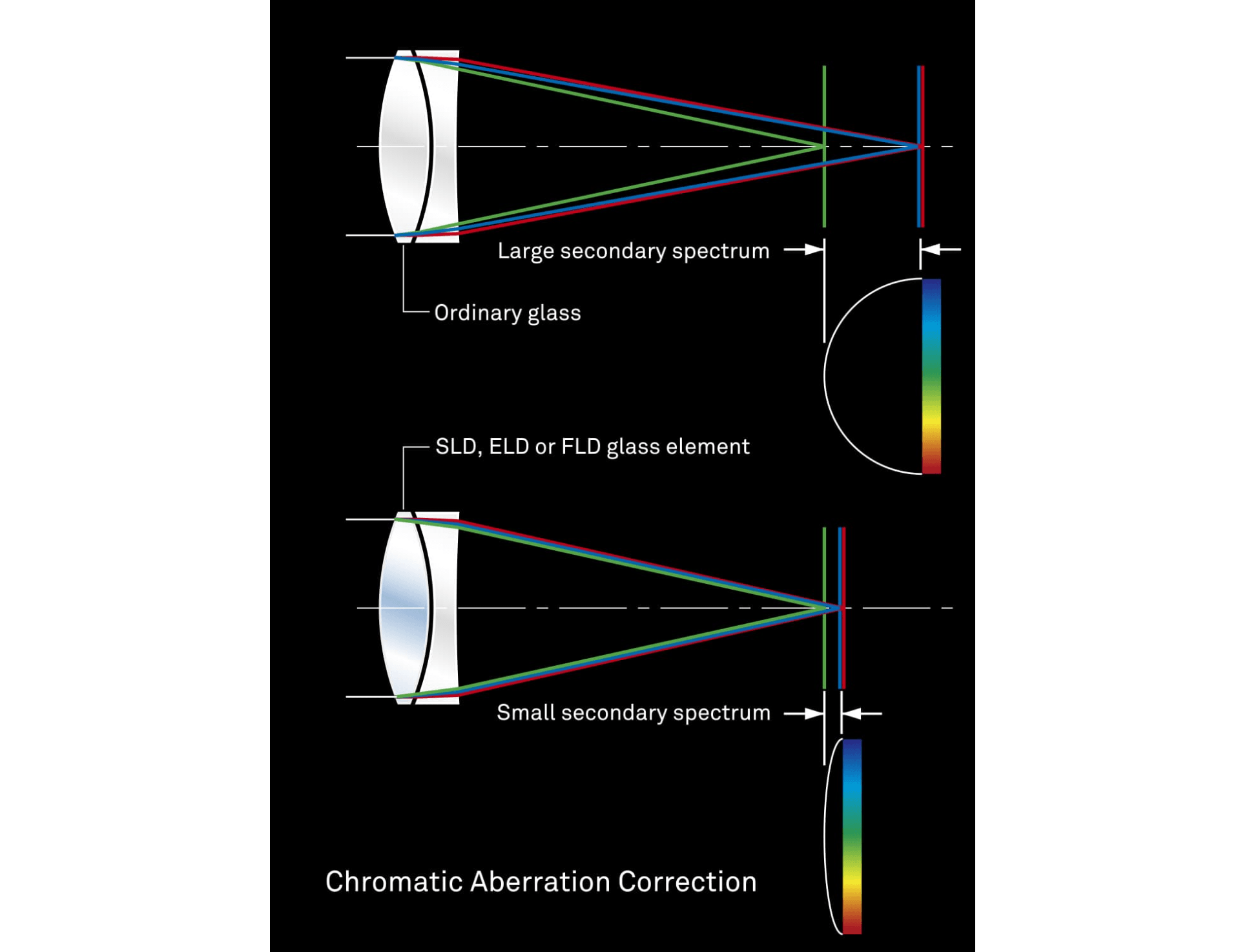
-
Designed to minimize flare and ghosting
From the start of the design process, Sigma measured flare and ghosting to establish an optical design that is resistant to strong incidental light sources such as backlight. At the prototyping stage, Sigma used not only simulations but actual photographic experiments to assess flare and ghosting under multiple criteria, identify the causes of these issues under a wide range of situations, and take measures to mitigate them. In addition, Sigma’s Super Multi-Layer Coating helps further reduce flare and ghosting and provide sharp, high-contrast images even in backlit conditions.

-
Delivering fast autofocus photography
An ultra-wide-angle lens that gives the photographer satisfying control
A large HSM, AF with full-time manual focus and all of Sigma’s latest design and manufacturing technologies help deliver an entirely new visual experience.

-
The large HSM delivers highly responsive autofocus
The large hypersonic motor (HSM) delivers ample torque to the focusing group for outstanding speed, ensuring exceptionally stable performance even at lower speeds. Along with the optimized AF algorithm, this feature delivers fast autofocus photography.
-
Fast AF with full-time manual focus
Full-time manual focus function allows the lens to be switched to manual focus simply by rotating the focus ring.
* Note: The operation of full-time MF may vary based on mount type.
-
Nikon electromagnetic diaphragm mechanism included
The Nikon mount version of this lens includes an electromagnetic diaphragm mechanism that allows it to receive the appropriate signals from the camera body. This feature ensures precision diaphragm control and stable Auto Exposure (AE) performance during continuous shooting.
-
Mount with Dust and Splash Resistant Structure
Since the area of the lens most vulnerable to dust and other foreign bodies is the mount, rubber sealing* helps provide peace of mind. In addition, the front lens element features a water- and oil-repellant coating that helps the lens perform well in the rain, near water, and in other challenging conditions.
* Except for Sigma mount
-
Rounded diaphragm
The 9-blade rounded diaphragm creates an attractive blur in the out-of-focus areas of the image.

-
High-precision, rugged brass bayonet mount
The brass mount combines high precision with rugged construction. Its treated surfaces and enhanced strength contribute to the exceptional durability of the lens.
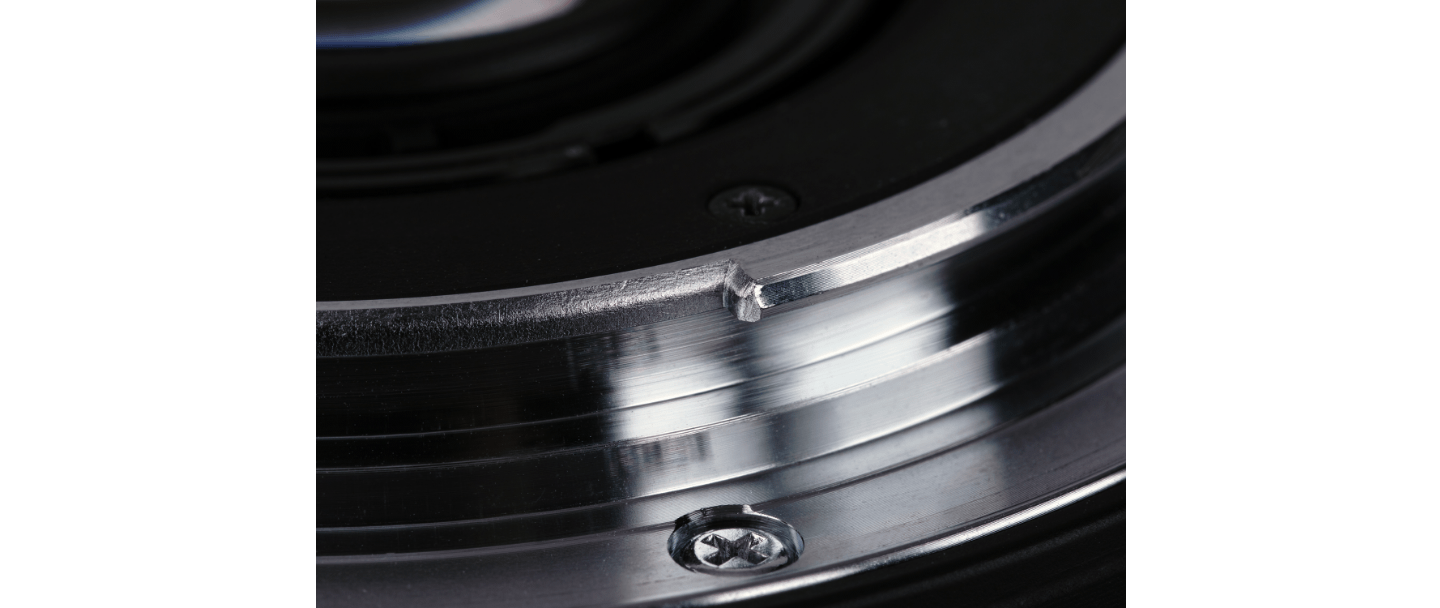
Lens construction
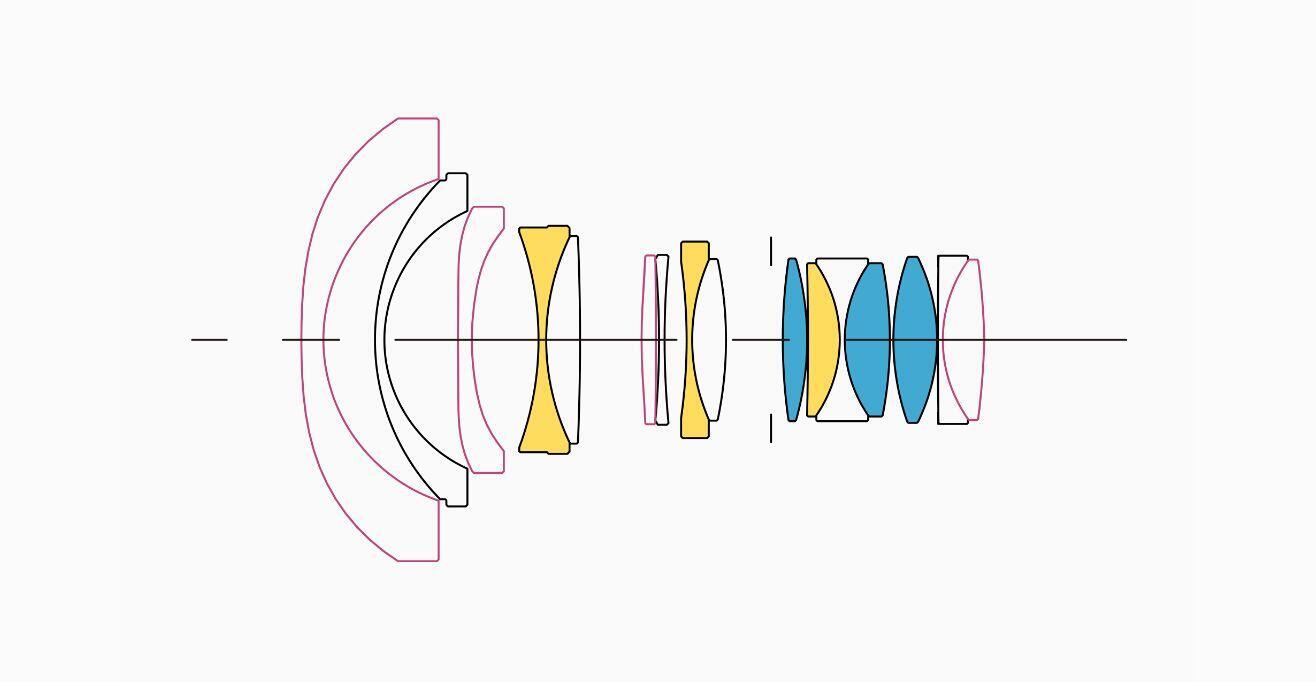
FLD glass
SLD glass
Aspherical lens
MTF Chart
The MTF (Modulation Transfer Function) is one of the measurements for evaluating a lens’ performance, and it shows how faithfully the contrast of the subject can be reproduced on the image plane. The horizontal axis shows the image height (distance from the center of the image in mm) and the vertical axis shows the contrast value (maximum value is 1).
The closer the 10 line pairs/mm curve is to 1, the higher the contrast and clarity of the lens is, and similarly, the closer the 30 line pairs/mm curve is to 1, the better the resolution and sharpness of the lens is.
*The MTF chart depicts the result at the wide-open aperture.
*For mirrorless lenses that support distortion correction, the horizontal axis shows the image height equivalent to when an L-Mount lens is attached to a Sigma L-Mount camera with distortion correction applied. (The effect of distortion correction may differ depending on the mount and camera used.)
*The spatial frequency indicates the variation on the image plane before distortion correction is performed.
-
Spatial frequency
S:Sagittal Line
M:Meridional Line
-
10lp/mm
-
30lp/mm
Diffraction MTF
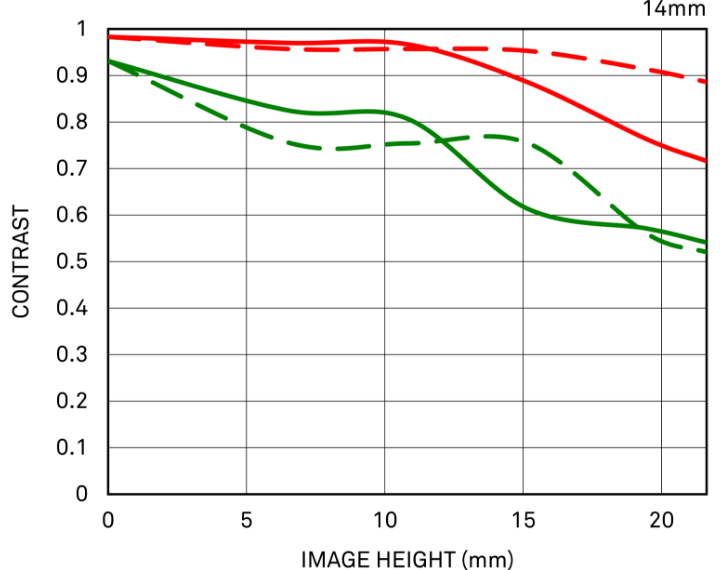
Geometrical MTF
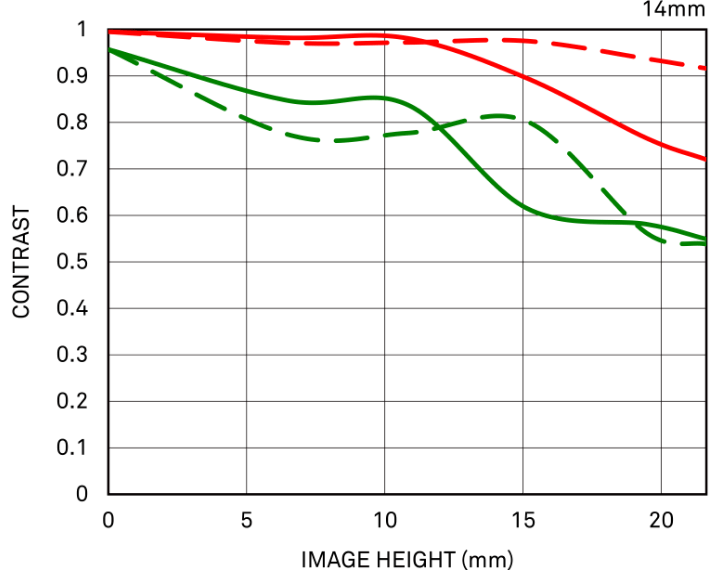
Distortion
effective distortion
When you take a picture of a lattice pattern, it will appear as the blue dotted line shows. The red line illustrates how the lattice pattern will appear in the actual picture when any lens distortion is taken into account.
relative distortion
In this chart, the horizontal axis shows the ideal image height (the distance from the center to the edge of the image [mm]). The vertical axis shows the extent of distortion. The extent of distortion is represented by how much Y, which is the actual image height, grows (or shrinks) against Y0 which is the ideal image height.
When you take the picture of a square object, if the distortion amount shows a minus value, the image will be seen as expanded (Barrel distortion). If the distortion amount is a plus value, it will be seen as a recessed (Pincushion distortion). When the distortion value is close to 0, the appearance of distortion is very minimal.
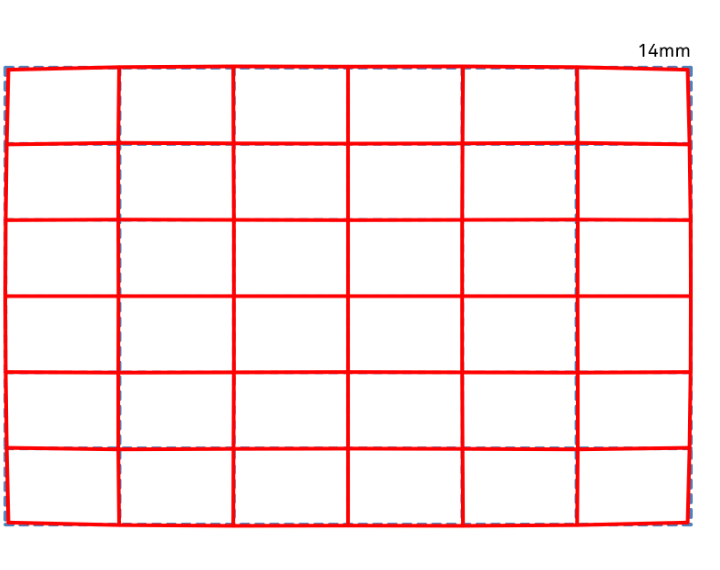
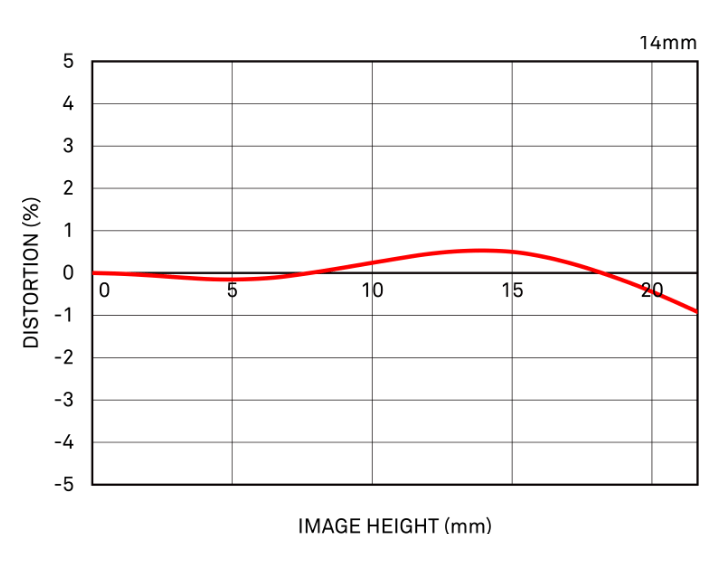
Vignetting
The horizontal axis shows the image height (the distance from the center to the edge of the image [mm]).The vertical axis shows the amount of light in the image (based on the amount of light in the image center being 100%). If the peripheral amount of light is lower than the center, the four corners of image will be darker (vignetting).
-
F1.8
-
F4
-
F8
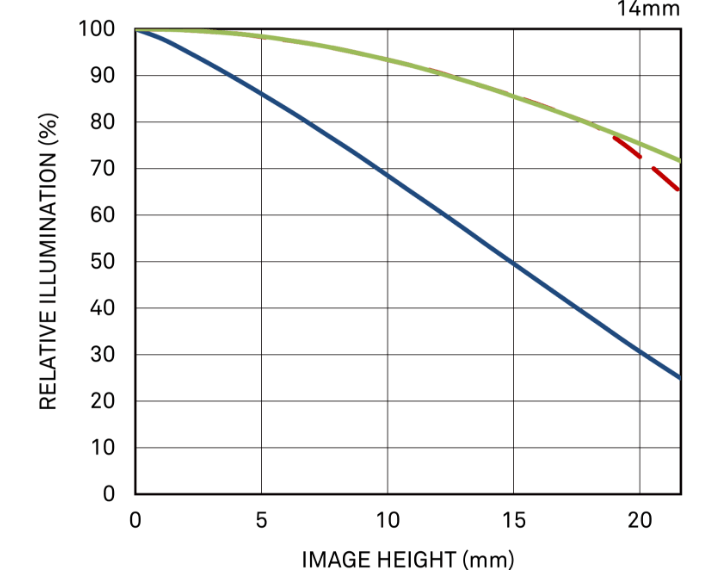
Introducing the world’s first and only*
F1.8 ultra-wide-angle lens
Long-awaited F1.8 brightness
A true high-speed lens that delivers a new dimension of visual experience
In taking photographs of starry skies or other celestial scenes at night, or of the seashore with a wide perspective, a large-diameter lens is a strong ally, since it allows the capture of a moving subject by adjusting shutter speed without relying on ISO sensitivity. With its full-frame 35mm coverage, 14mm focal length for an ultra-wide angle of view, F2 barrier-breaking F1.8, the Sigma 14mm F1.8 DG HSM | Art is the true high-speed ultra-wide-angle lens for which so many photographers have been waiting. Although some zoom lenses are available that can cover 14mm, the large diameter delivering F1.8 brightness is a singular advantage. Going beyond fast shutter speed, this lens can capture a swarm of fireflies with crystal clarity, a beautiful bokeh effect, and outstanding control of light streaking.
Art line delivers high-level artistic expression
Sigma is organizing all its interchangeable lenses into three product lines: Contemporary, Art, and Sports, each with a distinctive concept. Designed with a focus on sophisticated optical performance and abundant expressive power, our Art line lenses deliver high-level artistic expression. Offering astonishing rendering performance that meets the highest standard, they are perfect for landscapes, portraits, still-lifes, close-ups, and casual snaps. They are made for the kind of photography that unleashes the inner artist. A powerful ally in every genre of photography, Sigma’s Art line lenses excel both in the studio for formal works and outdoors for impressive shots of architecture, starry skies, and many other scenes.
Seventh 35mm full-frame prime lens to join the Art line
Launched in 2012, the Sigma 35mm F1.4 DG HSM | Art was the first lens in the Art line. Since then, Sigma has developed a wide variety of lenses for the line, and the Sigma 14mm F1.8 DG HSM | Art is the seventh prime lens in the line to offer 35mm full-frame coverage. Now even stronger, the Art line sets the new standard for prime lenses in the ultra-high-megapixel era.
* Among interchangeable lenses for digital SLRs as of February 2017